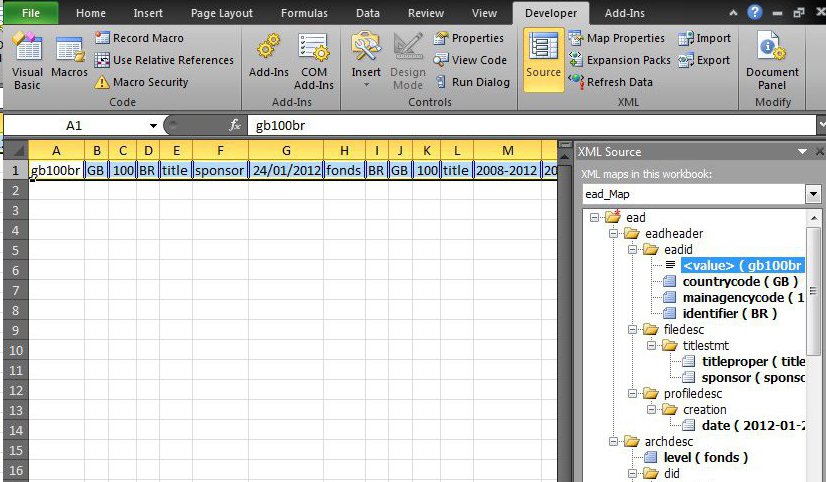Stacy Capner reflects on her first six months as Project Officer for the Archives Wales Catalogues Online project, a collaboration between the Archives and Records Council Wales and the Archives Hub to increase the discoverability of Welsh archives.
For a few years now there has been a strategic goal to get Wales’ archive collections more prominently ‘out there’ using the Archives Wales website. Collection level descriptions have been made available previously through the ‘Archives Network Wales’ project, but the aim now is to create a single portal to search and access multi-level descriptions from across services. The Archives Hub has an established, standards based way of doing this, so instead of re-inventing the wheel, Archives and Records Council Wales (ARCW) saw an opportunity to work with them to achieve these aims.
The work to take data from Welsh Archives into the Archives Hub started some time ago, but it became clear that getting exports from different systems and working with different cataloguing practices required more dedicated 1-2-1 liaison. I am the project officer on a defined project which began in April to provide dedicated support to archive services across Wales and to establish requirements for uploading their catalogue data to the Archives Hub (and subsequently to Archives Wales).
This project is supported by the Welsh Government through its Museums Archives and Libraries Division, with a grant to Swansea University, a member of ARCW and a long-standing contributor to the Hub. I’m on secondment from the University to the project, which means I’ve found myself back in my northern neck of the woods working alongside the Archives Hub team. This project has come at a time when the Archives Hub have been putting a lot of thought into their processes for uploading data straight from systems, which means that the requirements for Welsh services have started to define an approach which could be applied to archive services across Scotland, England and Northern Ireland.
Here are my reflections on the project so far:
- Wales has fantastic collections, holding internationally significant material. They deserve to be promoted, accessible and searchable to as wide an audience as possible. Some examples-
National Library of Wales, The Survey of the Manors of Crickhowell & Tretower (inscribed in the UNESCO Memory of the World Register, 2016) https://www.llgc.org.uk/blog/?p=11715
Swansea University, South Wales Coalfield Collection http://www.swansea.ac.uk/library/archive-and-research-collections/richard-burton-archives/ourcollections/southwalescoalfieldcollection/
West Glamorgan, Neath Abbey Ironworks collection (inscribed in the UNESCO Memory of the World register, 2014) http://www.southwales-eveningpost.co.uk/treasured-neath-port-talbot-history-recognised/story-26073633-detail/story.html
Bangor University, Penrhyn Estate papers (including material relating to the sugar plantations in Jamaica) https://www.bangor.ac.uk/archives/sugar_slate.php.en#project

- Don’t be scared of EAD ! I was. My knowledge of EAD (Encoded Archival Description) hadn’t been refreshed in 10 years, since Jane Stevenson got us to create brownie recipes using EAD tags on the archives course. So, whilst I started the task with confidence in cataloguing and cataloguing systems, my first month or so was spent learning about the Archives Hub EAD requirements. For contributors, one of the benefits of the Archives Hub is that they’ve created guidance, tools and processes so that archivists don’t have to become experts at creating or understanding EAD (though it is useful and interesting, if you get the chance!).
- The Archives Hub team are great! Their contributor numbers are growing (over 300 now) and their new website and editor are only going to make it easier for archive services to contribute and for researchers to search. What has struck me is that the team are all hot on data, standards and consistency, but it’s combined with a willingness to find solutions/processes which won’t put too much extra pressure on archive services wishing to contribute. It’s a balance that seems to work well and will be crucial for this project.
- The information gathering stage was interesting. And tiring. I visited every ARCW member archive service in Wales to introduce them to the project, find out what cataloguing systems they were using, and to review existing electronic catalogues. Most services in Wales are using Calm, though other systems currently being used include internally created databases, AtoM, Archivists Toolkit and Modes. It was really helpful to see how fields were being used, how services had adapted systems to suit them, and how all of this fitted in to Archives Hub requirements for interoperability.
- The support stage is set to be more interesting. And probably more tiring! The next 6 months will be spent providing practical support to services to help enable their catalogues to meet Archives Hub requirements. I’ll be able to address most of the smaller, service specific, tasks on site visits. The Hub team and I have identified a number of trickier ‘issues’ which we’ll hash out with further meetings and feedback from services. I can foresee further blog posts on these so briefly they are:
- Multilingualism- most services catalogue Welsh items/collections in Welsh, English items/collections in English and multi-language item/collections bilingually. However, the method of doing this across services (and within services) isn’t consistent. We’re going to look at what can be done to ensure that descriptions in multiple languages are both human and machine readable.
- Ref no/Alt ref- due to legacy issues with non-hierarchical catalogues, or just services personal preference, there are variations in the use of these fields. Some services use the ref no as the reference, others use the alt ref no as the reference. This isn’t a problem (as long as it’s consistent). Some services use ref no as the reference but not at series level, others use the alt ref no as the reference but not at series level. This will prove a little trickier for the Archives Hub to handle but hopefully workarounds for individual services will be found.
- Extent fields missing- this is a mandatory field at collection level for the Archives Hub. It’s important to give researchers an idea of the size of the collection/series (it’s also an ISAD(G) required field). However, many services have hundreds of collection level descriptions which are missing extent. It’s not something I’ll practically be able to address on my support visits so the possibility of further work/funding will be looked into.
- Indexing- this is understandably very important to the Archives Hub (they explain why here). For several archive services in Wales it seems to have been a step too far in the cataloguing process, mainly due to a lack of resource/time/training. Most have used imported terms from an old database or nothing at all. Although this will not prevent services from contributing catalogues to the Archives Hub, it does open up opportunities to think about partnership projects which might address this in the future (including looking at Welsh language index terms).
The project has made me think about how I’ve catalogued in the past. It’s made me much more aware that catalogues shouldn’t just be an inward-facing, local or an intellectual control based task; we should be constantly aware of making our descriptions more discoverable to researchers. And it’s shown me the importance of standards and consistency in achieving this (I feel like I’ve referenced consistency a lot in this one blog post; consistency is important!). I hope that the project is also prompting Welsh archive services to reflect on the accessibility of their own cataloguing- something which might not have been looked at in many years.
There’s a lot of work to be done, both in this foundation work and further funding/projects which might come of the back of it. But hopefully in the next few years you’ll be discovering much more of Wales’ archive collections online.
Stacy Capner
Project Officer
Archives Wales Catalogues Online
Related:
Archives Hub EAD Editor – http://archiveshub.ac.uk/eadeditor/
Archives Hub contributors – list and map










